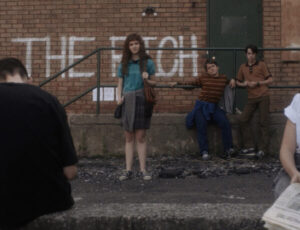Everyone steals a little something from work now and then, right? Paper clips, pencil sharpeners, infectious diseases from the bodies of our favourite celebrities – in Canadian director Brandon Cronenberg’s dystopian sci-fi debut, it’s all the same, really.
Maybe our culture’s connection with celebrities is a little weird. For Cronenberg, the obvious satirical step is towards the grotesque, and it’s a step taken with an enthusiasm belied by the film’s clinical aesthetic. Needles press into arms and mouths in giddy close-up as eager fans inject themselves with celebrity diseases in order to feel a greater sense of connection to those they idolize. Spurts of bile and sprays of blood pop into stark contrast against hospital-white floors. The camera lingers on shots of Hannah Geist steaks, a dull, fleshy food grown from the muscles cells of everyone’s favourite celebrity.
Celebrity worship can get a little ugly, after all. Antiviral makes that ugliness nice and literal for us.
Nestled front and centre in the absurdity of Antiviral’s world is Lucas Clinic technician Syd March, played with remarkable physicality by Caleb Landry Jones. Pale and sickly from the beginning, March’s deterioration through the film (what better way to smuggle a disease, of course, than by infecting oneself?) is affecting and evocative. The juxtaposition of March’s environment, relentlessly sterile in disaffected white and his person, a stumbling mess of liquid-sloshing biology, frames the film’s central dichotomy; what humans construct vs. what they are.
After all, argues the CEO of Lucas Clinic, celebrities are a group hallucination in which individuals voluntarily agree to take part. They are constructed, as perfectly and as cleanly as are the bare walls of Lucas Clinic, and they – or their diseases – are a product to be bought and sold. “If you get it on the right side it would be like she gave it to you in person,” March tells a waxen-faced fan as he prepares to inject the boy’s lips with Hannah Geist’s herpes. Someone has finally managed to forge a “real” connection between celebrity and fan, at least to the extent that to be biological means to be real. Is there a positive application for such technology? If there is, we don’t see it in Antiviral.
There is intrigue in the plot, and betrayal, and adventure. Like many early works in the science fiction genre, though, it is primarily the film’s ideas that engage us. While the story is occasionally muddled, and the relatively low budget is often evident, the questions Cronenberg asks, and the sense of spectacle with which he asks them, always bears us through.
And there is spectacle to be found. The film contains several striking sequences mined from somewhere near the junction of the physical and the technological. While biomechanical imagery may not be new to sci-fi, Cronenberg’s is, and there’s no doubt that some of it is going to stick with you for a while. The audacity and the visceral impact of several of the film’s key moments, augmented by a unique and haunting score, are a promise of a compelling future for the director.
A pleasant surprise is the film’s attention to humour. The settings are taxing – after a few minutes, the dead of Lucas Clinic and the concrete grunge of the city streets have become equally oppressive in their unpleasantness. The film is dystopian, and it capitalizes on this visually, but it can be exhausting. Key moments of comedy, both straightforward and bizarre, keep us involved, and being unexpected, the laughs are all the more welcome.
As a social satire, Antiviral is effective, but what makes it a particularly successful film is that its chosen target – the human compulsion to deify other human beings – is so fundamental. Like many great works of literature (though Cronenberg is not creating that, not yet), the film can be boiled down to essential questions about the human spirit. Most of us have heroes, people who we elevate even by the application of the term…why? What drives our need to venerate?
For all its unpleasantness, Antiviral is judicious in its use of the macabre and the violent. The film takes an unapologetic approach to deconstructing and questioning issues that are deeply affecting on both a personal and societal level today; the result is, at the very least, thought-provoking. As a straightforward story, it may not be the most engaging film playing on a Friday night, but its ideas more than make up for this, and they are certain to reward the engaged viewer.
Bottom line, there’s at least one guarantee that can be made for this film: no matter what, you’re going to walk out of the theatre thinking, Huh…I’ve never had that image in my brain before. In a medium saturated with attempts at high-impact imagery, Antiviral’s unique and effective contributions are commendable.








